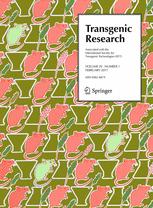Ver ítem
- xmlui.general.dspace_homeCentros e Institutos de InvestigaciónCICVyA. Centro de Investigación en Ciencias Veterinarias y AgronómicasInstituto de GenéticaArtículos científicosxmlui.ArtifactBrowser.ItemViewer.trail
- Inicio
- Centros e Institutos de Investigación
- CICVyA. Centro de Investigación en Ciencias Veterinarias y Agronómicas
- Instituto de Genética
- Artículos científicos
- Ver ítem
Development of a construct-based risk assessment framework for genetic engineered crops
Resumen
Experience gained in the risk assessment (RA) of genetically engineered (GE) crops since their first experimental introductions in the early nineties,
has increased the level of familiarity with these breeding methodologies and has motivated several agencies and expert groups worldwide to revisit the
scientific criteria underlying the RA process. Along these lines, the need to engage in a scientific discussion for the case of GE crops transformed with
[ver mas...]
Experience gained in the risk assessment (RA) of genetically engineered (GE) crops since their first experimental introductions in the early nineties,
has increased the level of familiarity with these breeding methodologies and has motivated several agencies and expert groups worldwide to revisit the
scientific criteria underlying the RA process. Along these lines, the need to engage in a scientific discussion for the case of GE crops transformed with similar
constructs was recently identified in Argentina. In response to this need, the Argentine branch of the International Life Sciences Institute (ILSI Argentina)
convened a tripartite working group to discuss a science-based evaluation approach for transformation events developed with genetic constructs which are
identical or similar to those used in previously evaluated or approved GE crops. This discussion considered new transformation events within the same or different species and covered both environmental and food safety aspects. A construct similarity concept was defined, considering the biological function of the introduced genes. Factors like environmental and dietary exposure, familiarity with both the crop and the trait as well as the crop biology, were identified as key to inform a construct-based RA process.
[Cerrar]

Autor
Becker, M.P.;
Boari, P.;
Burachik, Moisés;
Cuadrado, V.;
Junco, Mariano;
Lede, S.;
Lema, Martín;
Lewi, Dalia Marcela;
Maggi, Andrés;
Meoniz,Ignacio Alberto;
Noe, G.;
Roca, Cecilia;
Robredo, Claudio Gabriel;
Rubinstein, Clara;
Vicien, Carmen;
Whelan, Agustina;
Fuente
Transgenic research 25 (5) : 597–607. (October 2016)
Fecha
2016
ISSN
0962-8819 (Print)
1573-9368 (Online)
1573-9368 (Online)
Formato
pdf
Tipo de documento
article
Palabras Claves
Derechos de acceso
Restringido
 Excepto donde se diga explicitamente, este item se publica bajo la siguiente descripción: Creative Commons Attribution-NonCommercial-ShareAlike 2.5 Unported (CC BY-NC-SA 2.5)
Excepto donde se diga explicitamente, este item se publica bajo la siguiente descripción: Creative Commons Attribution-NonCommercial-ShareAlike 2.5 Unported (CC BY-NC-SA 2.5)

